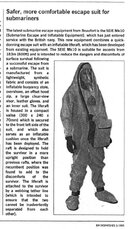Did you even bother to read the post?
Sorry, but there does exist a point at which considering a CESA as a viable means of dealing with OOG becomes ... dopey. CESA just doesn't scale to bigger/deeper dives. Therefore some of us simply accept other means of dealing with the possibility of OOG (gas management, redundancy, buddies, etc). Those practices can scale to just about any depth.
I did. I am also familiar with String's views on this subject and on dive planning generally. My comment that this was 'dopey' related more to boulderjohn's interpretation of String's post that a CESA is "not viable" below 15 feet. That is just putting it way too strongly. Of course it is viable. It just shouldn't be a first choice. "Not viable" means "not viable". It does not mean "should only be a very last resort", for which we have different words in the English language.
String advocates redudancy and careful planning to avoid the need. I think we all agree with that. But even if you are 205 feet down and inside a wreck, if there is no other gas available - it is a pretty frikkin' viable option.






